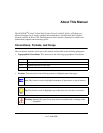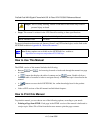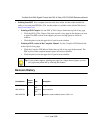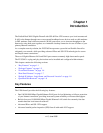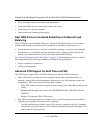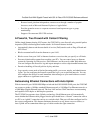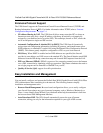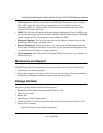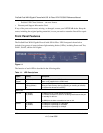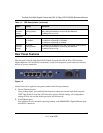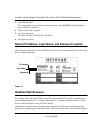
ProSafe Dual WAN Gigabit Firewall with SSL & IPsec VPN FVS336G Reference Manual
Introduction 1-3
v1.2, June 2008
– Browser based, platform-independent, remote access through a number of popular
browsers, such as Microsoft Internet Explorer or Apple Safari.
– Provides granular access to corporate resources based upon user type or group
membership.
– Supports 10 concurrent SSL VPN sessions.
A Powerful, True Firewall with Content Filtering
Unlike simple Internet sharing NAT routers, the FVS336G is a true firewall, using stateful packet
inspection (SPI) to defend against hacker attacks. Its firewall features include:
• Automatically detects and thwarts denial of service (DoS) attacks such as Ping of Death and
SYN Flood.
• Blocks unwanted traffic from the Internet to your LAN.
• Blocks access from your LAN to Internet locations or services that you specify as off-limits.
• Prevents objectionable content from reaching your PCs. You can control access to Internet
content by screening for Web services, Web addresses, and keywords within Web addresses.
You can configure the firewall to log and report attempts to access objectionable Internet sites.
• Permits scheduling of firewall policies by day and time.
• Logs security events such as blocked incoming traffic, port scans, attacks, and administrator
logins. You can configure the firewall to email the log to you at specified intervals. You can
also configure the firewall to send immediate alert messages to your email address or email
pager whenever a significant event occurs.
Autosensing Ethernet Connections with Auto Uplink
With its internal 4-port 10/100/1000 Mbps switch and dual 10/100/1000 WAN ports, the FVS336G
can connect to either a 10 Mbps standard Ethernet network, a 100 Mbps Fast Ethernet network, or
a 1000 Mbps Gigabit Ethernet network. The four LAN and two WAN interfaces are autosensing
and capable of full-duplex or half-duplex operation.
The FVS336G incorporates Auto Uplink
TM
technology. Each Ethernet port will automatically
sense whether the Ethernet cable plugged into the port should have a “normal” connection such as
to a PC or an “uplink” connection such as to a switch or hub. That port will then configure itself to
the correct configuration. This feature eliminates the need to worry about crossover cables, as
Auto Uplink will accommodate either type of cable to make the right connection.





